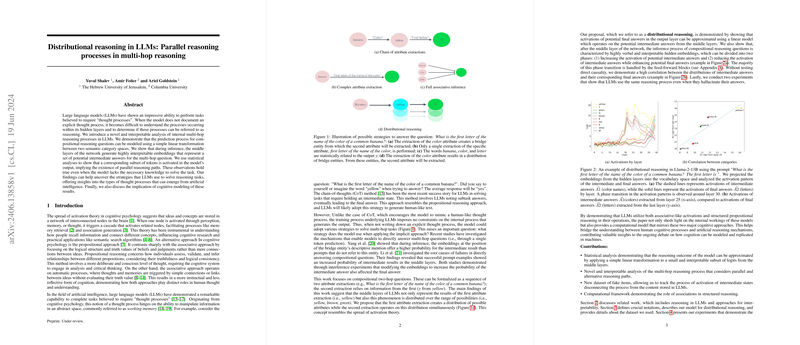Distributional reasoning in LLMs: Parallel reasoning processes in multi-hop reasoning
Authors: Yuval Shalev, Amir Feder, Ariel Goldstein
LLMs exhibit impressive capabilities in performing tasks previously believed to require thought processes. The paper "Distributional reasoning in LLMs: Parallel reasoning processes in multi-hop reasoning" by Yuval Shalev, Amir Feder, and Ariel Goldstein explores the internal operations of LLMs, exploring the implications of intermediate layer activations in multi-hop reasoning tasks. The research introduces a novel analytical approach to understand how LLMs leverage intermediate states to solve compositional reasoning questions.
Key Findings
The investigation reveals that during inference, the middle layers of the network generate highly interpretable embeddings representing potential intermediate answers for multi-hop questions. This phenomenon is evidenced by:
- Linear Transformation Model: The paper demonstrates that the prediction process for compositional reasoning questions can be modeled using a simple linear transformation between two semantic category spaces. Specifically, the activations of potential intermediate answers (e.g., colors) can predict the final answers (e.g., first letters of colors) with a high degree of accuracy (average across different question types and models).
- Dynamic Activation Patterns: Analysis shows that embeddings from middle layers exhibit significant activations for intermediate answers. These activations then transition to activations for final answers in subsequent layers. This pattern indicates a multi-phase reasoning process where initial layers focus on intermediate answers and final layers refine these into the final predictions.
- Parallel Reasoning Paths: The research identifies that a subset of tokens, representing potential intermediate answers, are highly activated in the model's output, suggesting the existence of parallel reasoning paths. This distributional reasoning persists even when the model lacks the necessary knowledge to solve the task, implying a robust internal reasoning mechanism.
- Hallucination Consistency: Experiments with fictitious subjects and attributes reveal that LLMs use the same reasoning processes even when they generate hallucinated answers. The statistical methods applied to genuine data generalized accurately to these fictitious scenarios, underscoring the independence of the reasoning process from training data specifics.
Implications
Theoretical Implications:
- Cognitive Modeling: The findings align with theories in cognitive psychology, such as the spread of activation theory, which posits that ideas and concepts are interconnected in the brain. This work suggests that LLMs might engage in a similar associative activation process, bridging the gap between human cognitive processes and artificial reasoning mechanisms.
- Understanding AI Thought Processes: By uncovering the intermediate activation dynamics, the paper contributes to the broader understanding of how LLMs emulate thought processes, providing a framework for future research into the computational modeling of cognition.
Practical Implications:
- Model Interpretability: The distributional reasoning framework enhances the interpretability of LLMs by providing a method to visualize and understand the intermediate steps leading to a model's final answer. This can be particularly useful in identifying and addressing sources of model error, such as hallucinations.
- AI System Design: The ability to model and predict the internal reasoning paths of LLMs can inform the design of more robust and reliable AI systems, particularly in applications requiring complex multi-step decision-making processes.
Future Directions
The research opens several promising avenues for further investigation:
- Diverse Question Structures: Future work could explore the applicability of distributional reasoning in different multi-hop question structures, expanding beyond the specific framework used in this paper.
- Alternative Semantic Categories: Examining the distributional reasoning process for categories that are less well-defined (e.g., numerical values, dates) could provide deeper insights into the versatility and limitations of LLMs’ reasoning capabilities.
- Causality of Reasoning Paths: Further research could seek to establish direct causal relationships within the reasoning processes, potentially through targeted interventions and manipulations of intermediate activations.
- Model Scaling and Variability: Investigating how different LLM architectures and scales (e.g., larger or specialized models) affect the distributional reasoning dynamics could refine our understanding of the generalizability of these findings.
Conclusion
This paper presents a significant contribution to our understanding of the internal processes underlying LLMs' reasoning capabilities. By modeling compositional reasoning through a linear transformation framework and demonstrating the existence of parallel reasoning paths, the paper provides valuable insights into both the theoretical and practical implications of LLMs' thought processes. This research lays the groundwork for future explorations into the cognitive modeling of AI and the development of more interpretable and reliable AI systems.
